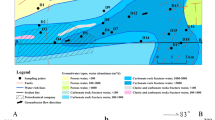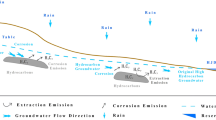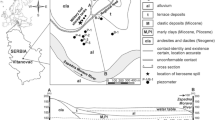Abstract
A rare super-large fractured karst aquifer located in Zibo city, Shandong Province of Northern China was polluted by petroleum hydrocarbons from a petrochemical company. Over the last 30 years, it has been the focus of several remediation efforts. In this study, the contamination and natural attenuation characteristics of the petroleum hydrocarbons were elucidated using hydrogeochemical indicators (DO, DOC, Cl−, HCO3−, pH, NO3−, and SO42−), petroleum hydrocarbons elements and environmental isotopes (δ15NNO3, δ18ONO3, δ13CDIC, and δ13CDOC). With the aid of GIS, statistical analyses, as well as first-order decay model and electron-acceptor-limited kinetic model, the spatio-temporal evolution characteristics of the petroleum hydrocarbons were modeled. Results showed a positive natural attenuation trend over the last 3 decades where intrinsic biodegradation mechanism was found to be the most important factor driving the degradation of hydrocarbons in the aquifer system. The hydrogeochemical association between the indicators and petroleum hydrocarbons provided the evidences of biodegradation and also served as markers, highlighting the occurrence of anaerobic respiration without methanogenic activities within the heterogenous karst media. Furthermore, the mean natural attenuation rate of petroleum hydrocarbons was calculated to be 3.76 × 10−3/day whereby the current highest petroleum hydrocarbons concentration (361.13 μg/L) is estimated to be degraded completely in 6 years under the present hydrogeological and environmental conditions.








Similar content being viewed by others
References
Abbasian F, Lockington R, Mallavarapu M, Naidu R (2015) A comprehensive review of aliphatic hydrocarbon biodegradation by bacteria. Appl Biochem Biotechnol 176:670–699. https://doi.org/10.1007/s12010-015-1603-5
Alvarez PJ, Illman WA (2005) Bioremediation and natural attenuation: process fundamentals and mathematical models. John Wiley & Sons
Amos RT, Bekins BA, Delin GN, Cozzarelli IM, Blowes DW, Kirshtein JD (2011) Methane oxidation in a crude oil contaminated aquifer: delineation of aerobic reactions at the plume fringes. J Contam Hydrol 125:13–25. https://doi.org/10.1016/j.jconhyd.2011.04.003
Atlas RM (1981) Microbial degradation of petroleum hydrocarbons: an environmental perspective. Microbiol Rev 45(1):180–209
Cassidy DP, Srivastava VJ, Dombrowski FJ, Lingle JW (2015) Combining in-situ chemical oxidation, stabilization and anaerobic bioremediation in a single application to reduce contaminant mass and leachability in soil. J Hazard Mater 297:347–355. https://doi.org/10.1016/j.jhazmat.2015.05.030
Chen YD, Zhu XY (1999) Mechanisms of biodegradation of hydrocarbon contaminants in the groundwater in Dawu well field in Zibo. Guangxi Geology 12(2):31–34 (in Chinese)
Chen YD, Zhu XY, Liu JL (1998) Distribution characteristics and fate of hydrocarbons in Dawu water source in Zibo city. Chin Sci Bull 43(1):81–85
Chen YD, Zhu XY, Zhu YS, Jiang YP, Xie QL (2000) Transformations and hydraulic captures of petrochemical contaminants in a karst-fractured aquifer. Environ Geol 39(11):1304–1308
Chien LC, Yu HL, Schootman M (2013) Efficient mapping and geographic disparities in breast cancer mortality at the county-level by race and age in the U.S. Spat Spatiotemporal Epidemiol 5:27–37. https://doi.org/10.1016/j.sste.2013.03.002
Chiu HY, Verpoort F, Liu JK, Chang YM, Kao CM (2017) Using intrinsic bioremediation for petroleum–hydrocarbon contaminated groundwater cleanup and migration containment: effectiveness and mechanism evaluation. J Taiwan Inst Chem E 72:53–61. https://doi.org/10.1016/j.jtice.2017.01.002
Choi HY, Lee JY (2011) Groundwater contamination and natural attenuation capacity at a petroleum spilled facility in Korea. J Environ Sci 23:1650–1659. https://doi.org/10.1016/S1001-0742(10)60568-2
Declercq I, Cappuyns V, Duclos Y (2012) Monitored natural attenuation (MNA) of contaminated soils: state of the art in Europe-a critical evaluation. Sci Total Environ 426:393–405. https://doi.org/10.1016/j.scitotenv.2012.03.040
Garlick GD, Epstein S (1966) The isotopic composition of oxygen and carbon in hydrothermal minerals at Butte, Montana. Econ Geol 61:1325–1335
GB 5749–2006 (2006) Quality standard for drinking water, People's Republic of China, Ministry of Environmental Protection
Guo YL, Zhai YZ, Wu Q, Teng YG, Jiang GH, Wang JS, Guo F, Tang QJ, Liu SH (2016) Proposed APLIE method for groundwater vulnerability assessment in karst-phreatic aquifer, Shandong Province, China: a case study. Environ Earth Sci 75:112–114. https://doi.org/10.1007/s12665-015-4903-8
Guo YL, Wu Q, Li CS, Zhao ZH, Sun B, He SY, Jiang GH, Zhai YZ, Guo F (2018) Application of the risk-based early warning method in a fracture-karst water source, North China. Water Environ Res 90:206–219. https://doi.org/10.2175/106143017X15131012152771
Guo YL, Quan XQ, Wang QG, Zhang C, Wu Q (2019) Characteristics of groundwater chemistry in Dawu karst water source. South-to-North Water Transfers and Water Science & Technology (in Chinese). http://kns.cnki.net/kcms/detail/13.1334.TV.20191031.1138.002.html. Accessed 31 Oct 2019
Hillebrand O, Nödler K, Sauter M, Licha T (2015) Multitracer experiment to evaluate the attenuation of selected organic micropollutants in a karst aquifer. Sci Total Environ 506:338–343. https://doi.org/10.1016/j.scitotenv.2014.10.102
Jones DM, Head IM, Gray ND, Adams JJ, Rowan AK, Aitken CM, Bennett B, Huang H, Brown A, Bowler BFJ, Oldenburg T, Erdmann M, Larter SR (2008) Crude-oil biodegradation via methanogenesis in subsurface petroleum reservoirs. Nature 451:176–180. https://doi.org/10.1038/nature06484
Kendall C (1998) Tracing nitrogen source and cycling in catchments. In: Kendal C, McDonee JJ (eds) Isotope traces in catchment hydrology. Elsevier Science B.V, The Netherland, pp 519–576
Kim DJ, Park MR, Lim DS, Choi JW (2013) Impact of nitrate dose on toluene degradation under denitrifying condition. Appl Biochem Biotechnol 170:248–256. https://doi.org/10.1007/s12010-013-0176-4
Lan JK (1996) Simulation models of water-rock interaction in the aquifer of Linzi area, Zibo city, Shandong. Journal of Guilin Institute of Technology 16(4):410–414 (in Chinese)
Lang FS, Destain J, Delvigne F, Druart P, Ongena M, Thonart P (2016) Characterization and evaluation of the potential of a diesel-degrading bacterial consortium isolated from fresh mangrove sediment. Water Air Soil Poll 227:58–20. https://doi.org/10.1007/s11270-016-2749-7
Lee TH, Cao WZ, Tsang DCW, Sheu YT, Shia KF, Kao CM (2019) Emulsified polycolloid substrate biobarrier for benzene and petroleum-hydrocarbon plume containment and migration control–a field-scale study. Sci Total Environ 666:839–848. https://doi.org/10.1016/j.scitotenv.2019.02.160
Li D, Song XL, Niu PS (2001) A simulation of the groundwater environment and study on control of the petroleum pollution in water supply source of Dawu. Beijing Geology 13(4):20–24 (in Chinese)
Liu SL (2013) The analysis of water quality evaluation regular pattern and the pollution trend prediction of groundwater in Dawu well field, Zibo City. China University of Geosciences (Beijing), postgraduate thesis
Liu XH, Dai QL (1996) Remediation programme study on oil pollution in groudwater system. Journal of South China University of Technology (Natural Science) 24:188–192 (in Chinese)
Liu XH, Fu JM, Shen ZL, Zhong ZS (1996) Hydrogeochemical change induced by oil sewage leakage – a case of the groundwater source in Zibo city, Shandong province, China. Geochimica 25(4):331–338
Lv H, Wang Y, Su XS, Zhang YL (2015) Combined 14C and δ13C analysis of petroleum biodegradation in a shallow contaminated aquifer. Environ Earth Sci 74:431–438. https://doi.org/10.1007/s12665-015-4049-8
Lv H, Su XS, Wang Y, Dai ZX, Liu MY (2018) Effectiveness and mechanism of natural attenuation at a petroleum-hydrocarbon contaminated site. Chemosphere 206:293–301. https://doi.org/10.1016/j.chemosphere.2018.04.171
Lv H, Wang Y, Wang H (2019) Determination of major pollutant and biogeochemical processes in an oil-contaminated aquifer using human health risk assessment and multivariate statistical analysis. Hum Ecol Risk Assess 25(3):505–526. https://doi.org/10.1080/10807039.2018.1449099
Margalef-Marti R, Carrey R, Viladés M, Jubany I, Vilanova E, Graue R, Soler A, Oteroa N (2019) Use of nitrogen and oxygen isotopes of dissolved nitrate to trace fieldscale induced denitrification efficiency throughout an in-situ groundwater remediation strategy. Sci Total Environ 686:709–718. https://doi.org/10.1016/j.scitotenv.2019.06.003
Marić N, Matić I, Papić P, Beškoski VP, Ilić M, Gojgić-Cvijović G, Miletić S, Nikić Z, Vrvić MM (2018) Natural attenuation of petroleum hydrocarbons—a study of biodegradation effects in groundwater (Vitanovac, Serbia). Environ Monit Assess 190:89. https://doi.org/10.1007/s10661-018-6462-4
McMahon PB, Chapelle FH (2008) Redox processes and water quality of selected principal aquifer systems. Groundwater 46(2):259–271. https://doi.org/10.1111/j.1745-6584.2007.00385.x
Müller JB, Ramos DT, Larose C, Fernandes M, Lazzarin HS, Vogel TM, Corseuil HX (2017) Combined iron and sulfate reduction biostimulation as a novel approach to enhance BTEX and PAH source-zone biodegradation in biodiesel blend-contaminated groundwater. J Hazard Mater 326:229–236. https://doi.org/10.1016/j.jhazmat.2016.12.005
National Research Council (2000) Natural attenuation for groundwater remediation. National Academy Press, Washington, DC
Newell CJ, Kueper BH, Wilson JT (2014) Natural attenuation of chlorinated solvent source zones. Chlorinated solvent source zone remediation. Springer, New York, pp 459–508
Parker SR, Gammons CH, Smith MG, Poulson SR (2012) Behavior of stable isotopes of dissolved oxygen, dissolved inorganic carbon and nitrate in groundwater at a former wood treatment facility containing hydrocarbon contamination. Appl Geochem 27:1101–1110. https://doi.org/10.1016/j.apgeochem.2012.02.035
Qian H, Zhang Y, Wang J, Si C, Chen Z (2018) Characteristics of petroleum contaminated groundwater during natural attenuation: a case study in northeast China. Environ Monit Assess 190:80. https://doi.org/10.1007/s10661-017-6449-6
Reid JB, Reisinger HJ, Gray JC, Hullman AS (1999) A comparative assessment of the long-term behavior of MTBE and benzene plumes in Florida, USA. Nat Attenuat Chlorin Solv Petrol Hydrocarbons Other Org Compd 1:97–102
Shang YN (2013) Study on karst water level dynamic change for many years of Dawu water resources area in Zibo city. Land and Resources in Shandong Province 29:44–47 (in Chinese)
Spaldinga RF, Hirshb AJ, Exnerc ME, Littled NA, Kloppenborge KL (2019) Applicability of the dual isotopes δ15N and δ18O to identify nitrate in groundwater beneath irrigated cropland. J Contam Hydrol 220:128–135. https://doi.org/10.1016/j.jconhyd.2018.12.004
Sperfeld M, Rauschenbach C, Diekert G, Studenik S (2018) Microbial community of a gasworks aquifer and identification of nitrate-reducing Azoarcus and Georgfuchsia as key players in BTEX degradation. Water Res 132:146–157. https://doi.org/10.1016/j.watres.2017.12.040
Teng YG, Zuo R, Wang JS, Lin XY (2010) Progress in geochemistry of regional groundwater evolution. Adv Water Sci 21(1):127–136. https://doi.org/10.14042/j.cnki.32.1309.2010.01.002
United States Environmental Protection Agency (USEPA) (2004) How to evaluate alternative cleanup technologies for underground storage tank sites: a guide for corrective action plan reviewers
United States Environmental Protection Agency (USEPA) (2010) Green remediation best management practices: clean fuel & emission technologies for site cleanup. EPA 542-F-10-008, Washington DC
van der Waals MJ, Pijls C, Sinke AJ, Langenhoff AA, Smidt H, Gerritse J (2018) Anaerobic degradation of a mixture of MtBE, EtBE, TBA, and benzene under different redox conditions. Appl Microbiol Biotechnol 102:3387–3397. https://doi.org/10.1007/s00253-018-8853-4
Varjani SJ, Upasani VN (2017) A new look on factors affecting microbial degradation of petroleum hydrocarbon pollutants. Int Biodeterior Biodegrad 120:71–83. https://doi.org/10.1016/j.ibiod.2017.02.006
Wang JL, Jin MG, Lu GP, Zhang DL, Kang FX, Jia BJ (2016) Investigation of discharge-area groundwaters for recharge source characterization on different scales: the case of Jinan in northern China. Hydrogeol J 24(7):1723–1737. https://doi.org/10.1007/s10040-016-1428-5
Wu NJ, Zhang W, Wei WX, Yang SC, Wang HJ, Sun ZP, Song Y, Li PZ, Wang Y (2020) Field study of chlorinated aliphatic hydrocarbon degradation in contaminated groundwater via micron zero-valent iron coupled with biostimulation. Chem Eng J 384:123349. https://doi.org/10.1016/j.cej.2019.123349
Xing YQ, Dou M, Zhang Z, Fu B, Zhang YL (2008) Dynamic analysis and water quality evaluation of groundwater in Dawu water source. Henan Science 26(1):80–87
Yang J, Meng L, Guo L (2019) In situ remediation of chlorinated solvent-contaminated groundwater using ZVI/organic carbon amendment in China: field pilot test and full-scale application. Environ Sci Pollut Res 25(6):5051–5062. https://doi.org/10.1007/s11356-017-9903-7
Yu X, Ghasemizadeh R, Padilla I, Irizarry C, Kaeli D, Alshawabkeh A (2015) Spatiotemporal changes of CVOC concentrations in karst aquifers: analysis of three decades of data from Puerto Rico. Sci Total Environ 511:1–10. https://doi.org/10.1016/j.scitotenv.2014.12.031
Zhu XY, Xu SH, Si JF (1997) Application of tracing test to the remediation of contaminated fracture-karst water in Zibo city. Carsologica Sinica 16(2):131–144
Zhu XY, Liu JL, Qian XX (1999) The influence of Zihe stream on the groundwater resources of the Dawu well field and on the discharge at the Heiwang iron mine, Zibo City area, Shandong Province, China. Hydrogeol J 7:477–482
Zhu XY, Liu JL, Zhu JJ, Chen YD (2000) Characteristics of distribution and transport of petroleum contaminants in fracture-karst water in Zibo area, Shandong Province, China. Sci China 43(2):141–150
Acknowledgments
The authors would like to thank the editor and two anonymous reviewers for their constructive comments, which helped us improve the quality of the paper.
Funding
Financial support was provided by the National Natural Science Foundation of China (41702277), National Natural Science Foundation of Guangxi Province (2017GXNSFFA198006, 2018GXNSFDA050002), Special Fund for Basic Scientific Research of Chinese Academy of Geological Sciences (JYYWF20182002, 2020004), UNESCO/IUGS (IGCP 661), Global Karst Resource Ecology United laboratory-Comparative study of classical karst areas between China and Slovenia (KY201802009), The national key research and development program of China (2016YFC0502306), and the Geological Survey Projects of CGS (DD20190022, DD20190452).
Author information
Authors and Affiliations
Corresponding author
Additional information
Responsible editor: Xianliang Yi
Publisher’s note
Springer Nature remains neutral with regard to jurisdictional claims in published maps and institutional affiliations.
Highlights
• Spatio-temporal concentrations of petroleum hydrocarbons had an obvious decreasing trend over the last 30 years with a mean natural attenuation rate of 3.76 × 10−3 /day.
• The occurrences of aerobic and anaerobic respiration without methanogenic activities were demonstrated by analyzing hydrogeochemical indicators, petroleum hydrocarbons and environmental isotopes.
• The current highest petroleum hydrocarbons concentration (361.13 μg/L) in the contaminant sources area could be degraded completely in 6 years based on the present biodegradation capacity and mean natural attenuation rate.
Rights and permissions
About this article
Cite this article
Guo, Y., Wen, Z., Zhang, C. et al. Contamination and natural attenuation characteristics of petroleum hydrocarbons in a fractured karst aquifer, North China. Environ Sci Pollut Res 27, 22780–22794 (2020). https://doi.org/10.1007/s11356-020-08723-2
Received:
Accepted:
Published:
Issue Date:
DOI: https://doi.org/10.1007/s11356-020-08723-2




